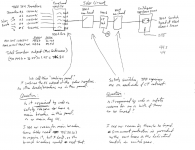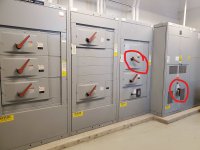mddorogi
Member
- Location
- Ann Arbor, MI
Any comments on this are appreciated. My company is going to be installing a 600 kW DC, 510 kW AC system using SolarEdge 480V inverters. There will be 4-120 kW inverters and one 30 kW inverter. A few points are not clear to me, or let's say I get differing statements about what's acceptable and to code. My Master Electrician and myself seem to view things the same way, but a couple of electrical PE's see it differently. Another electrical PE is in the middle somewhere.
The (simple) one-line is attached. The meter in the middle is the solar generation meter required by our utility DTE. It is CT rated, and they also require a visible knife-blade disconnect on each side of that CT cabinet. The questions are:
- is the combiner panels REQUIRED to have a main breaker (some electrical PE's say yes by NEC 705.30(A))
- is either one or both of the 800A switches REQUIRED to be fused?
I'm pretty convinced that my simplistic way of thinking about it is wrong, and I'd like to know why.
In my opinion, the 800A fuses in the dedicated solar switch in the switchgear provide overcurrent protection from the grid side, which is all you really need.
It seems that adding more fuses or a main breaker in the combiner panel, while not harmful, do not add anything other than expense and complexity.
The inverters have a maximum output fault current to 50% higher than the max continuous rating; for example 120 kW inverter is max continuous 144.3A and max output fault 213.3A. The inverters cannot produce anything like the fault current coming from the grid side. Each inverter has its own appropriately sized breaker, and adding a main doesn't seem to accomplish anything.
I admit that I don't understand fault conditions with inverters and what happens in real life when an inverter either gets fried or there is a short in the AC output circuit somewhere. I've never seen that happen.

The (simple) one-line is attached. The meter in the middle is the solar generation meter required by our utility DTE. It is CT rated, and they also require a visible knife-blade disconnect on each side of that CT cabinet. The questions are:
- is the combiner panels REQUIRED to have a main breaker (some electrical PE's say yes by NEC 705.30(A))
- is either one or both of the 800A switches REQUIRED to be fused?
I'm pretty convinced that my simplistic way of thinking about it is wrong, and I'd like to know why.
In my opinion, the 800A fuses in the dedicated solar switch in the switchgear provide overcurrent protection from the grid side, which is all you really need.
It seems that adding more fuses or a main breaker in the combiner panel, while not harmful, do not add anything other than expense and complexity.
The inverters have a maximum output fault current to 50% higher than the max continuous rating; for example 120 kW inverter is max continuous 144.3A and max output fault 213.3A. The inverters cannot produce anything like the fault current coming from the grid side. Each inverter has its own appropriately sized breaker, and adding a main doesn't seem to accomplish anything.
I admit that I don't understand fault conditions with inverters and what happens in real life when an inverter either gets fried or there is a short in the AC output circuit somewhere. I've never seen that happen.



